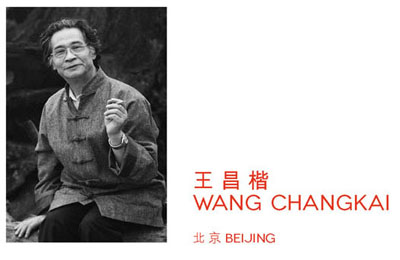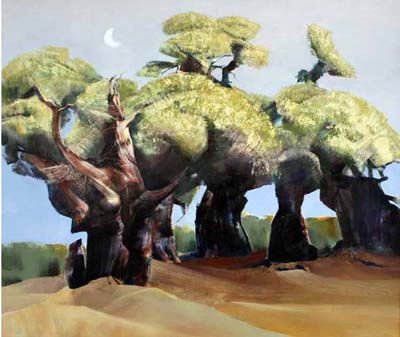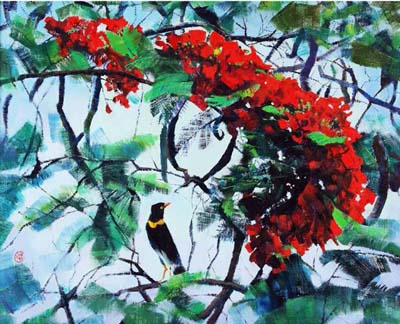
男,1940年生於河北定縣的詩書世家,自幼受酷愛繪畫。
他於1957年考入北京藝術學院預科,1960年升入學院本科,受教於吳冠中先生,專習油畫;1963年畢業後從事美術教育工作長達15年;1978年調入全國總工會文工團,從事舞臺美術工作,並因隨團各地演出、拍攝之機,遍遊祖國美麗山川,為此後的油畫創作打下良好基礎。
在數十年艱苦的藝術實踐中,他一直不離不棄地跟隨吳冠中先生,並深受吳先生藝術理念的影響。為發展屬於中國的油畫藝術體系,付出大量的汗水和努力,終於在八十年代建立了自己鮮明的藝術風格,並於九十年代進入藝術成熟期。
他的作品清新明快,既發揮了油畫亮麗的色彩和三維空間的視覺效果,又融入中國畫講究的筆法之有效運用和不可修改之難度,形成了有別於西方油畫的新的中國油畫技法,為中國繪畫藝術增添了屬於自己民族的新畫種。
在歷年多次國內外的重要展覽中,他的作品都獲得藝術界和收藏界良好評價,作品並被中外藝術機構收藏及拍賣。出版有多本個人藝術專集。
Male, born in a literary family in Zhengding, Hebei Province
in 1940. Wang developed his ardent love for art since his
early childhood.
In 1957 he was admitted to the preparatory class of Beijing
Art Academy and furthered his study as an undergraduate
in 1960. He majored in oil painting and was under the
guidance of Mr Wu Guanzhong. Since graduation in 1963,
he had engaged in the career of art education for 15 years.
In 1978, he was transferred to the Literary Unit of the
National Workers’ Union to take charge of the stage design.
It provided a great opportunity for him to travel all over the
magnificent country with the performance troupes, which
laid a profound foundation for his future landscape painting
creation.
In several decades of arduous artistic endeavor, he has been
following Mr. Wu ceaselessly, and is deeply influenced by Mr
Wu’s artistic philosophy. He has made painstaking efforts in
pursuit of developing an oil painting system that uniquely
belongs to China. Finally, he has successfully established
his own distinctive style in 1980s, and came to maturity in
1990s.
Wang’s works are refreshingly lively and lucid. Not only do they bring the vividness of hues and the three dimensional
visual impact of oil paintings into full play, but also incorporate
the highly-effective manipulation of brushstrokes, as well as
the irrevocable nature of Chinese painting into it. All of these
are a brand new technique of Chinese oil painting, which
is distinctively different from that of the West. He created a
new genre of Chinese art, which only belongs to the Chinese
nation.
Wang’s works are highly acclaimed by art connoisseurs and
collectors in many of his important exhibitions held at home
and abroad throughout all these years, and are collected
and auctioned by local and international art establishments.
Various art albums of Wang have been published.
胡楊
poplar
110x130xm
oil on canvas

胡楊在惡劣的大漠生態環境下生長,卻有 “生而千年不死, 死而千年不倒,倒而千年不爛。”之美譽。形容其頑強的生命力和堅韌不拔、不屈不撓的氣節。作者以雄勁瀟灑、近乎中國大寫意式的筆觸,把胡楊的雄姿和精神表現得淋漓盡致,同時開拓出中國式油畫的新篇章。
Populus in the harsh desert environment grow, there “Millennium born dead, dead a thousand years back, the idea is not bad but the millennium.” Reputation. Describe its vitality and perseverance, indomitable integrity. The author portrays the forces chic, almost Chinese freehand brushwork style, the majestic and spiritual Populus performance thoroughly, and open up a new chapter in Chinese-style painting.
Phoenix Flower
90X110CM
OIL ON CANVAS

《鳳求凰》旅居海南十餘年的畫家 王昌楷選取了熱帶地區盛夏嬌豔似火的鳳凰花(又稱火焰樹)為主畫面,作為海南特產的鷯哥自然也成為畫中的精靈。鷯哥、天空、枝幹的黑與白很好地協調了鳳凰花紅與綠的矛盾,瀟灑靈動的筆法譜寫了相互追逐歌唱的生命讚歌。強烈的色彩對比,旋轉的充滿動感的構圖,畫家用油畫的藝術語言,結合中國畫的審美,吸取了中國書法的精華,展現出精准的一筆到位,不可修改的中國式筆法。整張畫面無不體現出對生命激情的歌頌,畫家以東方的審美,油畫色彩,中國畫的氣韻,體現了中國人的積極樂觀向上的價值觀。
Painter Wang Changkai, who
has lived in Hainan for over 10
years, chose as his subject for this
painting the Phoenix Flower (also
known as the Fountain Tree),
which is found in the tropics and
known for its fire-like beauty at the
height of summer. The grackle,
which is indigenous to Hainan, is
the featured spirit in the painting.
The black and white colorings of
the grackle, the sky, and the tree
branches give balance to the
Phoenix Flower’s red and green
contrasts. The unrestrained and
nimble brush strokes resulted in
the composition of a song of praise
for life. Through the presentation
of strong color contrasts and a
dynamic composition, the painter
combined the artistic language of
oil painting with aesthetics unique
to Chinese painting. In absorbing
the essence of Chinese calligraphy,
the painter has displayed a level
of unchangeable recision that
is unique to the Chinese style of
painting. The result is a painting
that manifests a passionate praise
for life. By combining Oriental
aesthetics, the rich colors found
in oil paintings, and the texture
unique to Chinese paintings, the
painter has demonstrated the
Chinese people’s enthusiasm and
optimism toward life.